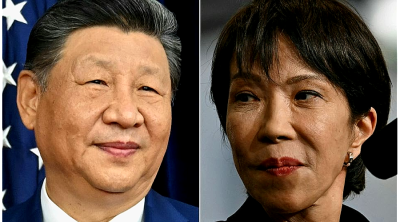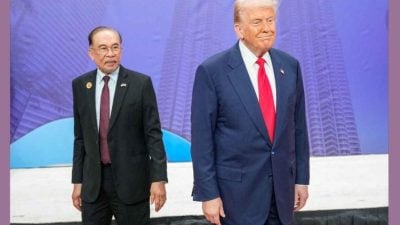
In recent weeks, US President Donald Trump’s announcement of sweeping tariff hikes on goods from 180 countries sent shockwaves through global markets.
From disbelief to outrage, governments and businesses scrambled to make sense of what many now see as the start of a new era of American economic coercion, if the American people allow him to have his way!
Among the primary targets is China. But what exactly has China done to warrant this treatment?
For over four decades, China has built world-class infrastructure and manufacturing capacity to serve as the world’s factory—delivering affordable goods to the US and beyond.
In return, it became a major consumer of American services, from software to Hollywood films, and still holds over US$600 billion in US Treasury bills—supporting US fiscal stability.
So again—what’s the offence?
To many observers, these sweeping tariffs reflect less a commitment to “fair trade” than a deeper strategy to isolate China.
The implicit message: join the US in pressuring China—or face tariffs yourself.
This is no longer just about trade. It’s about maintaining US dominance, reducing unsustainable debt, and reviving a long-declining manufacturing base.
Reassessing US economic power
In 2024, the US accounted for US$4.11 trillion in imports—roughly 12.5 percent of global trade. With just 4.1 percent of the global population, it still generates 27.4 percent of global GDP. This makes America both an economic giant and a vital consumer hub.
But this power is now being used more aggressively.
Since Trump’s first term, US trade policy has veered toward protectionism. While framed as “reciprocity,” these measures have triggered inflation, disrupted global supply chains, and undermined the multilateral trade system that underpinned global prosperity for decades.
For exporters in developing countries, the implications are stark. Many built their business models around US demand.
Today, those models are crumbling. Some may abandon the US market altogether. Others may attempt to localize production—a costly endeavor, made harder by high American operational costs, a weakened industrial base, and regulatory complexity.
BRICS: Can it replace the US market?
No region has historically matched the US in terms of consumption. The American economy thrives on spending—often borrowed—and this consumer culture has fueled global economic growth for close to a century.
It powered the post-war rise of Japan, Korea, Taiwan, and Southeast Asia. It propelled China’s manufacturing boom.
For three decades under the World Trade Organization, the US and G7 countries supplied capital, markets, and know-how for global industrialization.
But that era is changing.
In 2024, BRICS expanded to include Saudi Arabia, Iran, Egypt, Ethiopia, and the UAE. The enlarged BRICS+ bloc now exceeds the G7 in several key indicators:
■ 32 percent of global GDP (PPP) vs. G7’s 29.9 percent
■ 45 percent of global population vs. G7’s 10 percent
■ Vast natural resources, rising industrial output, and growing middle classes
BRICS is accelerating efforts to develop non-dollar trade mechanisms, challenging US financial dominance and building a multipolar economic order.
While it cannot yet match America’s consumption power, BRICS, with sustained growth, may offer a long-term alternative.
This realignment won’t be easy—but it is necessary. Think tanks and governments must now focus on helping BRICS nations stimulate domestic demand, reduce reliance on Western markets, and build resilient, inclusive economies.
What would global trade look like without the US?
If US demand shrinks or disappears, the export-led growth model many countries rely on would take a massive hit. Developing countries must act to lessen the shock.
This means:
■ Stimulating domestic consumption
■ Raising incomes and escaping the middle-income trap
■ Investing in education, infrastructure, and innovation
■ Expanding healthcare and social safety nets to build confidence
■ Unlocking domestic savings to fuel long-term transformation
At the heart of consumption is hope. When people believe in the future, they invest in it—through spending, entrepreneurship, and innovation.
The US reckoning: Return to the real economy
Trump’s tariffs are a symptom of a deeper issue: America’s struggle to pivot back to industrial strength after decades of financialisation. Consider:
■ Why did the US shift from trade surpluses to chronic deficits?
■ Why have 90,000 factories closed since the 1980s?
■ Can any economy thrive on speculation alone, without fundamentals in the real economy?
Five structural factors behind US industrial decline:
1. Post-WWII dominance bred complacency
2. The dollar’s reserve currency role enabled unchecked debt
3. Offshoring hollowed out domestic manufacturing
4. Financialization prioritized asset inflation over production
5. Policy neglected long-term national interest
These are cautionary lessons for all developing nations.
Malaysia at an inflection point
As global certainty fractures, Malaysia faces a critical choice: adapt—or be left behind.
Here’s what we must do:
■ Reengineer the economy toward high-tech, high-value production.
Start with low-hanging fruit—add value to palm oil by developing consumer products instead of exporting crude commodities.
Upgrade our semiconductor sector. Prioritize environmental care to sustain tourism and agriculture.
■ Strengthen our role as a resilient, trusted partner in global supply chains.
Collaborate with ASEAN—sharing knowledge and growing regional demand will secure everyone’s future. Make food security a regional effort.
Work based on comparative advantage—Singapore has world-class education to share; Malaysia’s Chinese schools can help ASEAN develop Mandarin proficiency.
In the world post-2050, more people in the world will speak Mandarin.
■ Invest in people and ecosystems. Build connected infrastructure, green energy, and innovation platforms.
■ Be bold in financing development. Tap into our green assets—sunlight, water, biodiversity—and share them with ASEAN to build full regional integration.
Conclusion: Beyond survival, toward sovereignty
This is Malaysia’s moment—not just to weather the storm, but to define a new path. To do so, we must mobilize government, business, civil society, and the people.
It will take courage. It will take strategy. It will take iron will. It requires us to let go of outdated models and invest in long-term national interest.
But the reward is worth it: a stronger, more sovereign Malaysia—built not on speculation, but on real productivity.
We owe it to our children—and grandchildren.
(Foong Wai Fong is Founding Director of Megatrends Asia. She worked with world-renowned futurist John Naisbitt on Megatrends Asia, published in 2000, which successfully predicted the rise of China and Asia.)
ADVERTISEMENT
ADVERTISEMENT








































